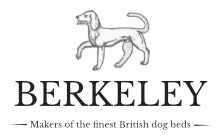Following on from reports related to the potentially harmful effects of foams and flame retardants in mattresses and soft furnishings, a recent study by the Ecology Center in the USA exposed a series of shocking facts and figures about disturbingly high levels of toxic chemicals found in pet products widely available for sale in the USA.
The study covered a wide range of imported pet products including food, treats, toys and collars but a key focus was on Dog Beds and pet bedding.
Of the 69 sample imported beds tested by the Ecology Center, only 3 were completely free from any detectable levels of harmful chemicals.
It is widely believed that around 98% of Dog Beds sold in the USA are imported from China – Either as finished beds or as inserts for local finishing. The figure is believed to be not much different here in the UK.
Foam, and in particular, Memory Foam Dog Beds were one of the key areas of concern.
Memory foam can be produced relatively cheaply, it is easy to cut and shape and is light in weight making it a preferred material for dog bed, mattress and soft furnishings manufacturers.
However, memory foam is a petrochemical derived bi-product and as such consumers need to be vigilant as to the chemicals contained therein.
In the study, the chemicals were detected either as a core constituent in the manufacture of the foam, as an added ingredient or 'filler' -in the production process to bulk-up the foam or as a fire retardant added to the foam or sprayed on afterwards to help to diminish the highly flammable nature of foam-based products.
The chemicals found by the Ecology Center study included Antimony, Arsenic, Bromine, Chlorine, Formaldehyde, Lead, Mercury, PBDE's (Polybrominated Diphenyl Ether), Phthalates and Tin.
These chemicals are linked to a wide variety of illnesses ranging in scale from headaches, often severe allergies, nausea, skin complaints, lethargy and, ironically, joint pain, through to infertility, birth defects and cancer.
The chemicals can be absorbed through the skin, by ingestion from washing and grooming and by breathing in the chemicals as they off-gas from the bed.
Remember that when you make a dog bed you’re basically making a bellows and it’s got air inside, so when you sit on it, it puffs this stuff out so it's not just your dog that gets it. If the bed gets damp, as is likely, it turns into a semi liquid state that is even more easily absorbed by skin.
In other words, a cumulative effect that could slowly be poisoning your dog. The nature of off-gassing means that all members of the household can be exposed to the risk.
So, how can you protect YOUR dog?
We advise that you -
- Stay away from pet beds without a known brand name.
- Make sure you can contact the manufacturer or importer to ask questions BEFORE purchase.
- Satisfy yourself as to the full traceability of the components used in the manufacturing process – If it is Chinese, you need to be particularly vigilant.
- Elect to buy Dog Beds made using natural ingredients such as wool ,cotton, coir, natural latex or products recognised to be relatively inert such as hollow fibre polyester.
- Avoid Dog Beds treated with flame retardants.
- If you already have a Memory Foam Dog Bed make sure that it is hermetically sealed within an outer cover and ensure that it is used in a well ventilated area. .
- Do not purchase dog beds made with 'Egg Crate Memory Foam', 'Memory Foam Chips' or similar. The construction hastens the off-gassing process and, frankly, they are next to useless as an effective, supportive dog bed filling.
 Handmade In the UK
Handmade In the UK

